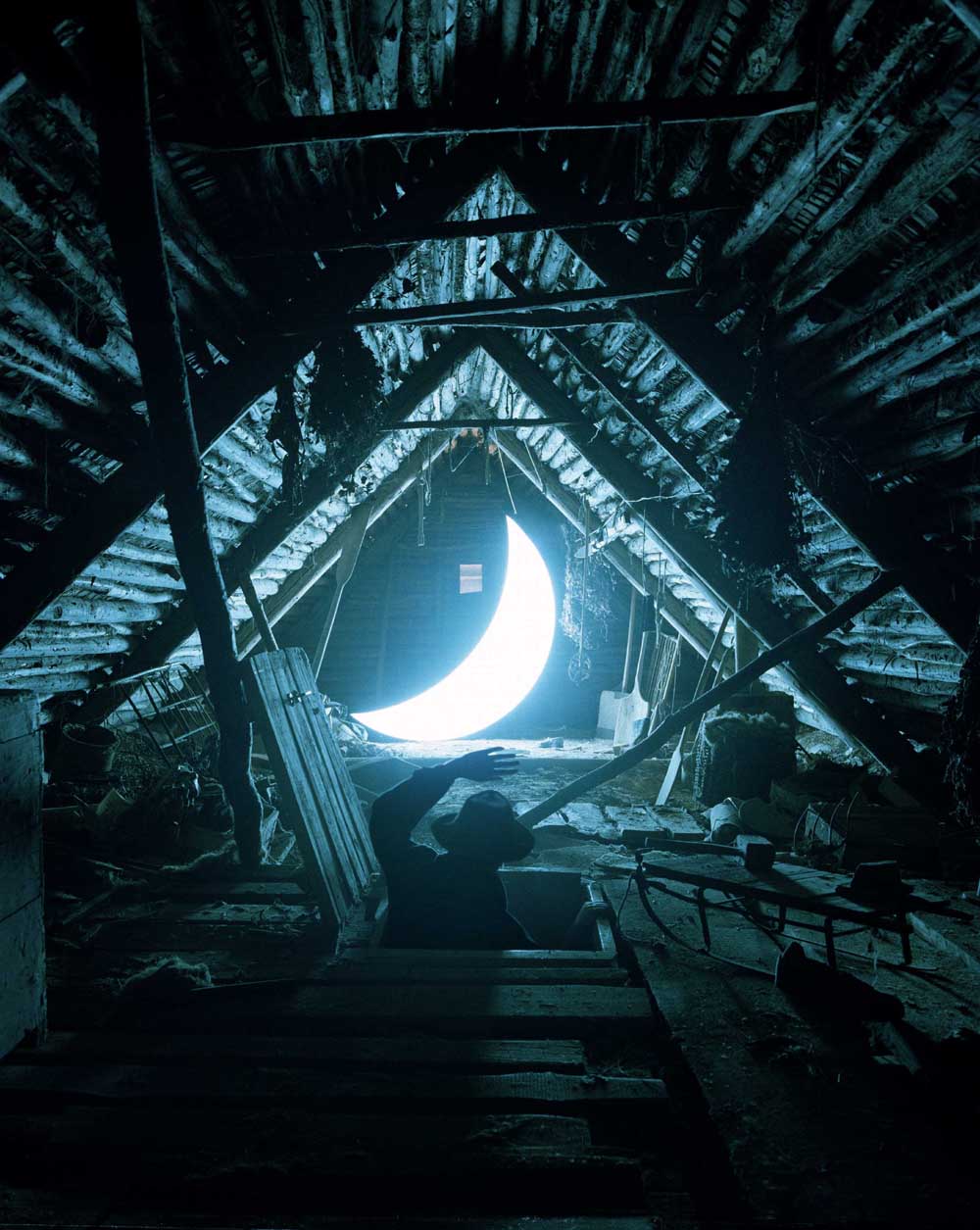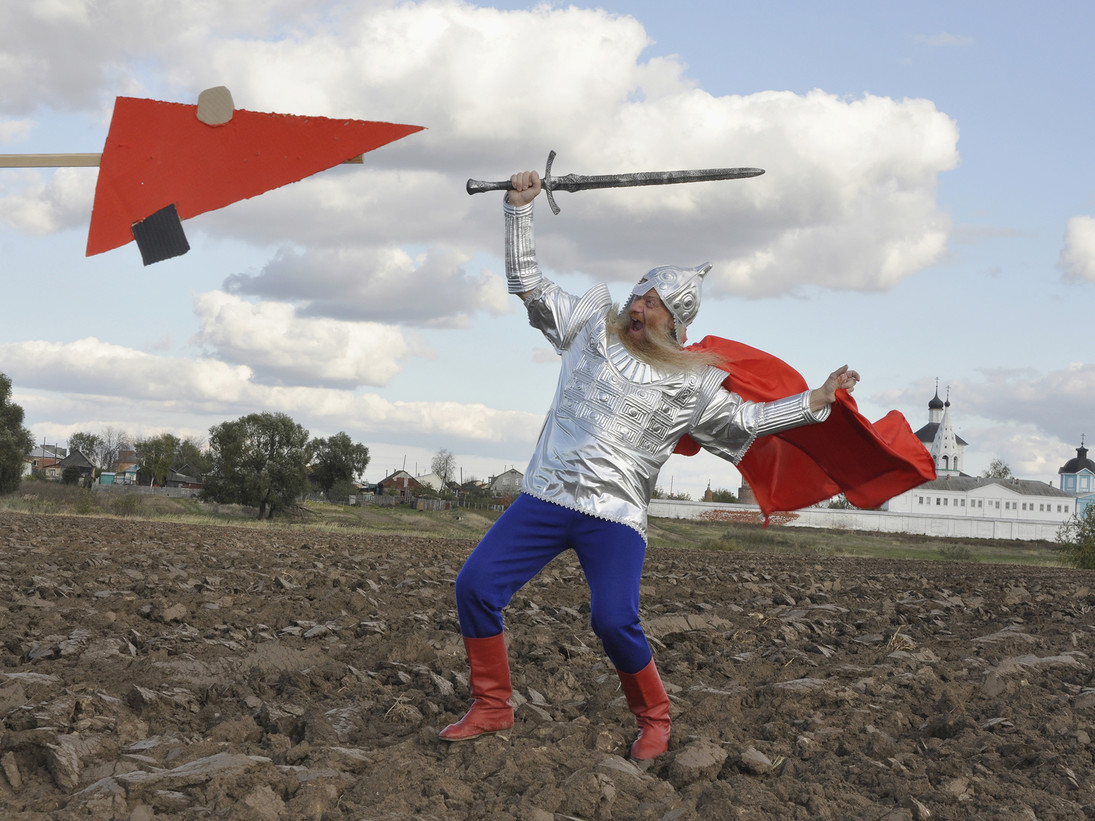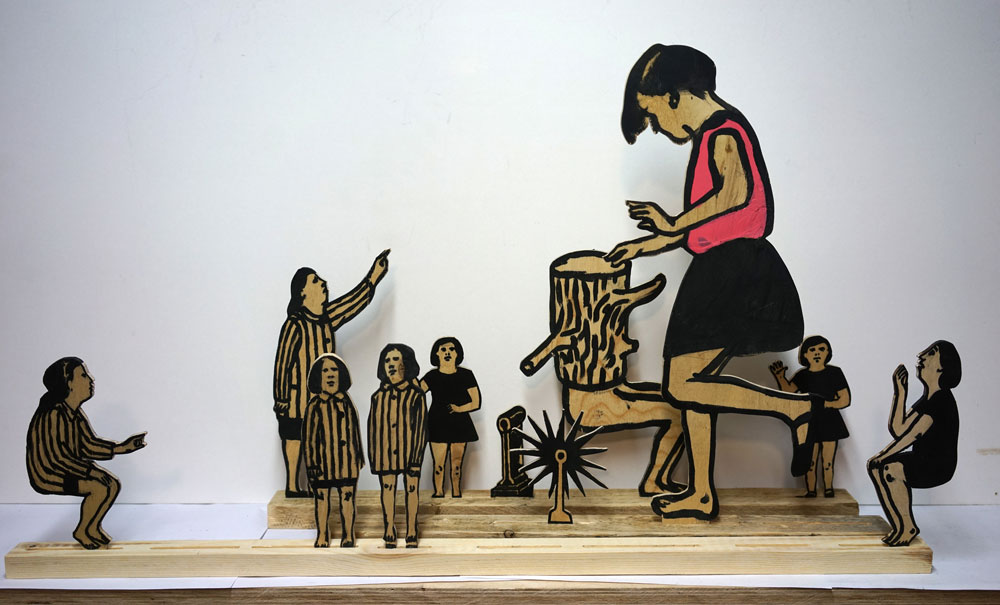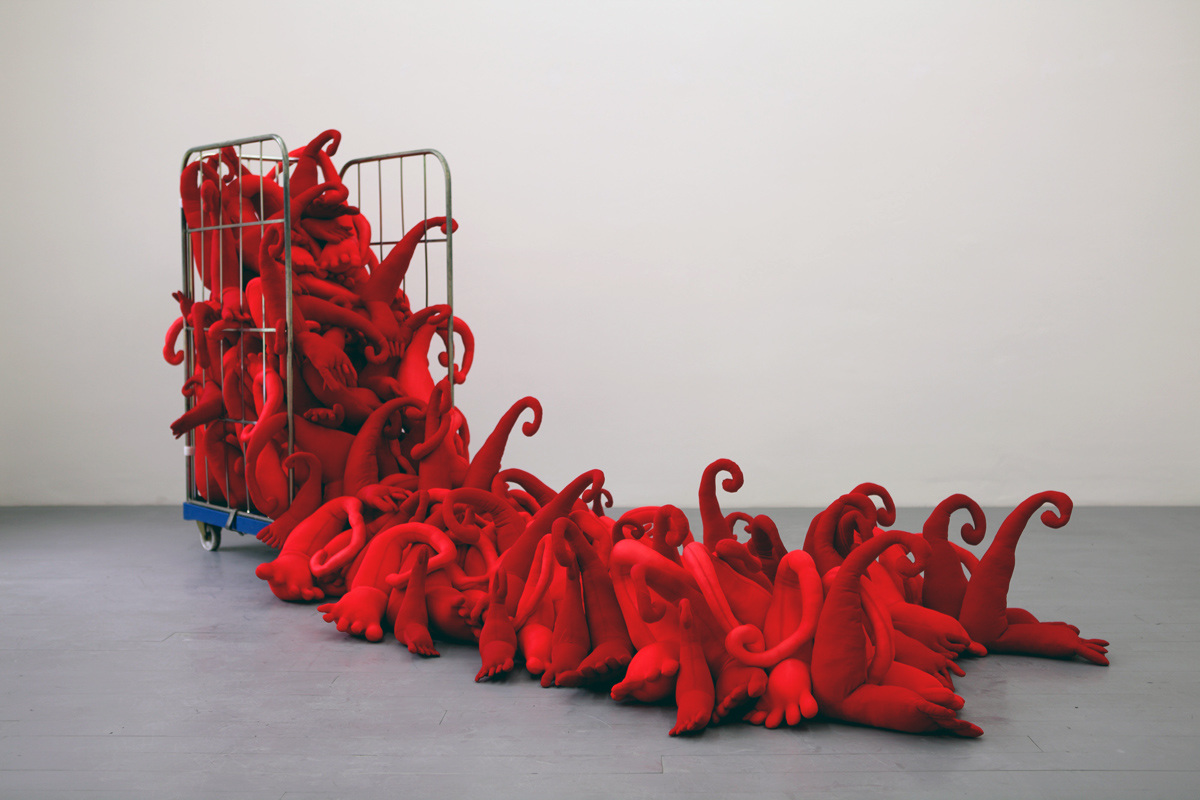INTERVIEW: Anna Prosvetova meets with Leonid Tishkov, a Russian contemporary artist, to talk about his exhibition at Erarta Galleries London
Above: Leonid Tishkov, Journey of the Private Moon / Courtesy of Erarta Galleries London
Anna Prosvetova met with Leonid Tishkov, a contemporary artist from Moscow, before the opening of his Private Moon exhibition at Erarta Galleries London, for which Leonid brings back to London his famous installation for the first time since 2013. We talked with Leonid about philosophy behind the Private Moon project and his role as a curator of Maxim Boxer’s third exhibition and auction of contemporary Russian art in London.
Anna Prosvetova: How did the idea of the Private Moon project come about?
Leonid Tishkov: The story of Private Moon appeared in a number of my other projects. In general, I am an artist who tells a story. The Private Moon project has become a very well-known and long-lasting, apparently, because its poetic and visual power is more expressive than my other stories. Private Moon first appeared to the public at the big festival of contemporary art “Art-Klyazma” in 2003. It was an outdoor installation, which I dedicated to the Belgian surrealist artist Rene Magritte. There is a picture by him called September 16, 1956; it is a luminous moon in the crown of a dark tree. That is actually all that is depicted there. It might have been a usual postmodernist trick that so many artists are fond of: to take an image and transfer it to another context. In my case, a miracle happened: the moon turned out to be such a powerful creature, that it has overcome all the allusions and began its independent existence. For some period I became her companion, helping to move around the Earth, but not in the sky. There is a real Moon in the space; we do not compete with it, but sometimes start a dialogue.
Why I have chosen the moon and not the sun, you ask? Because the moon is a friend of poets, wanderers and romantics. In our post-industrial times, full of contradictions and violence, my private, absolutely quiet, even delicate project Private Moon brings back the art of poetry, which people are lacking today.
AP: Your project has already visited many countries. Could you tell us if the audience reaction was different?
LT: The journey of Private Moon has been going on since 2003; this is a round-the-word trip similar to the real moon – from New Zealand to Svalbard, from the US to Siberia, from Taiwan to Kazakhstan. I have not noticed any great differences in the perception of the story, related to the nationality of my audience or their cultural traditions. The light of the moon has been living with humans since his appearance in the world; it is the most ancient archetype. Tides associated with changes in the lunar gravity led to the fact that the fish learned to breathe the air and they have grown limbs. Therefore, when a viewer looks at my moon, they feel the presence of a miracle somewhere in the subconscious, understanding, though, that it is just a huge lamp.
On the island of Taiwan I had a great tour with the moon around various amazing places. Local people expressed their great love to me as an artist and called me Mr Moon. They invited me twice, always in the fall, when they celebrate the feast of the moon. Specifically for Taiwanese children I wrote and illustrated a story called A boy and the moon; it was connected with my installation with the moon and the stars in the Museum of Modern Art for children; I wanted to tell them a fairy-tale. Then this book was published in Russian and recently has been translated into Japanese. It seems to me that Private Moon is a kind of work that brings together all the people on this planet as the light of a fire in cold woods, attracting everybody who feels the poetry and believes in the possibility of a miracle.

Leonid Tishkov, Journey of the Private Moon / Courtesy of Erarta Galleries London
AP: Our readers would be interested to hear more about the upcoming exhibition at Erarta Galleries London. Have you exhibited the project in London before?
LT: I have already staged exhibitions in London, and the moon also came with me. What is surprising is that similar to the real moon, which every night returns to the sky, my moon has been featured twice in exhibitions at Bargehouse in London. And every time she was beautiful, was she not? For the first time she appeared in 2007 at the exhibition called Moscow Breakthrough and then in 2013 at the same venue as a part of a very successful project Republic of the Moon, which was organized by a group of curators Arts Catalyst, working at the intersection of art and science. This exhibition included a number of international artists working with the theme of the moon. I was responsible for the poetry, so to speak.
Now, in 2015 Erarta Galleries London decided to showcase my moon again, contacting my friend, collector and art dealer Maxim Boxer in order to arrange the visit of the Private moon to their space. Together with Maxim Boxer and Erarta Galleries London I am also working on an exhibition and following auction with the common theme Cartoon-Like Art in Russia, where I present my amusing woks.
AP: Leonid, in the beginning of your career you worked more with graphics and design. How did you become interested in installations and why did you decide to work in this direction?
LT: Yes, I started with graphics and design and there is one graphic work from Anatomy of Russiaseries, which you will be able to see at Cartoon-Like exhibition, together with several paintings about Dabloids. I have been a famous cartoonist in the Soviet Union since the beginning of the 1970s, but after my unauthorized participation in a show in West Berlin they refused to publish my works in magazines. Thus, I became an underground artist and began drawing comics, albums, where my strange and absurd characters appeared for the first time: Dabloids, Stomaki, Divers Living in the Trunk. In the early 1990s these creatures have become more substantial and started gathering objects around them, including sculptures, videos, pictures and books. From all this my installations grew. This form of representation resembles theatre, where I stage my plays Dabloids, Divers and others. Therefore, my installations are a derivative of my artistic adventures. Journey of the moon becomes surrounded with all sorts of events, objects, stories, photographs; they create a resemblance of a museum. I even came up with an idea of the Museum of Imaginary Moons, where one could find a moon of Federico Garcia Lorca, Giorgio De Chirico, the poet Basho and even the devil from Nikolai Gogol’s story.

Blue Noses Group, Struggle with Suprematism / Courtesy of Maxim Boxer
AP: Could you tell us more about your work with Maxim Boxer on his third auction of contemporary art, Cartoon-Like. What are the main ideas you as a curator wanted to convey in the pre-auction exhibition?
LT: I have mentioned to Maxim that he should look at this idea, because there is a trend in contemporary art, but nobody mentions it in Russia. Frequently art historians prefer to work with already existing formulas, without trying to come up with new ideas. For example, one of the renowned art critics has decided that the most important art movement in Russia today is conceptualism and everybody started repeating it. I, on contrary, believe that art is wider than the frameworks outlined by art historians; it is a live stream, bubbling and sweeping away all the fences on its way.
The number of good artists is much greater than the number of those artists who are counted and located in art history books as guardians of a ‘racial purity’. Maxim became interested in this idea and offered me to organise this exhibition, to prove, let’s say, that there is actually an art movement like this. This auction is an attempt to designate this area. It could be important especially now in connection with the growth of obscurantism in our country and throughout the world.
AP: How did you as an artist feel in a role of a curator? Did you have any special approach to the presentation of the works included in the show?
LT: Maxim Boxer and Konstantin Semkin, his partner, took care of the organisation of the auction. Maxim is a great professional in the art world, especially in relation to its business side; it is his prerogative. I completely trust him with this aspect. My main work was to review the artistic community to find common goals and interests, identify trends and create a drive. I also wrote several texts, some sort of “zongos” about the artists. I am an artist myself, so I know what we, the creators, need. We all need a good word, our own company and love in the end of it! In general, I have had to ‘cook porridge’ and then others will eat it. Remember, I have fallen from the moon.

Shishkin-Hokusai. The Miracle Of Grouth. 2016 / Courtesy of Maxim Boxer
AP: Do you have any particular expectations for the upcoming auction? Which works do you think will be the most interesting for buyers?
LT: If I were a wealthy English cattle dealer, fashionable lawyer, a plastic surgeon or a fugitive Russian oligarch, and, in addition, a collector of all the strange and exciting things, I would have certainly bought something for my home or an office. But there are different people out there with different tastes and styles. I enjoy many works presented for the auction. There is a picture of Igor Verichev from the legendary time when we thought that the world would change and we would see the sky full of diamonds over the Kremlin. It is a unique work! Or, for example, this chic piece by Alexander Savko. Do you know how difficult it is to pull the canvas on an oval stretcher and to ensure that the Ministry of Culture of Russia would certify it? Or myRussian Blazonry: I do not know what to do with it back at home; most likely I will not be able to exhibit it there, because somebody could complain. There is a work by Shishkin-Hokusai at a very affordable price. I am sure there are collectors of Shishkin’s works in London, so with this piece they would be able to have even ‘Hokusai’ in addition to a new ‘Shishkin’! Some works presented here are in very short supply as, for instance, this Vassily Slonov’s Olympic pictures. It is very difficult to find them on the market today, and this auction offers three pieces from this series. These works could be properly called a cultural heritage today, a document of an epoch. If you are an aspiring collector with a tight budget, I would recommend to look at his fly swatters: they are cheap and cheerful, as they say.
AP: What do you think about the current state of contemporary Russian art?
LT: The current state of Russian art is quite normal. There are many artists; young people are very active and established artists do not give up; most importantly, they do not give in to melancholy. At the same time, art business still operates on a very modest scale, but maybe it is a good thing, because the artists work independently, without following directions from galleries.
There are issues with art education in Russia; there are no contemporary academies or other institutions where they would teach contemporary art. Therefore, we are again a little bit behind Europe, but ahead of Mongolia and Azerbaijan. However, I do not think it is productive to compare art in different countries in the era of globalization, when it is difficult to understand where an artist works: today he could be in Krasnoyarsk, and tomorrow in Copenhagen…

Dabloids installation in Juri Svestka gallery, Berlin. 2012 / Courtesy of www.leonidtishkov.com
AP: What are your future projects?
LT: We say that if you want to make God laugh, tell him about your plans. I will try to do it now: there is a major exhibition opens at the Art Museum of Nizhny Tagil, a city in the Urals, on May 16. Then in June Private Moon will travel to South Korea, in August afterwards to Romania, where it will be staged in the castle of Dracula, and I would like to try and capture this. I think it is a pity that London still has not seen my Dabloids and people even do not know about them! May be I should work on this.
Private Moon
By Leonid Tishkov
Part of Russian Art Week
At Erarta Galleries London
29 May – 05 June
Please visit the website for more details on the exhibition.
Leonid Tishkov’s official website.
This interview was originally published on Russian Art and Culture.